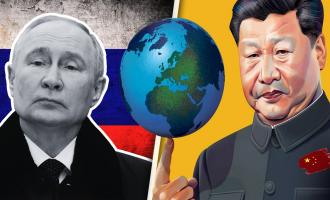Even as China extended support to India battling an unprecedented coronavirus wave merely a week ago, it appears there is no love lost between the governments of the two countries as a consequence of the clashes that broke out in Ladakh in June last year. India, going ahead with its 5G trials, has snubbed Huawei, one of the biggest tech companies in China and across the world, in a move that will impact India-China relations.
In an attempt to ease the tensions between the two governments as the pandemic rages on in India, China’s Foreign Minister Wang Yi, last week, reached out to the External Affairs Ministry, voicing their support for India and aiding procurement of necessary medical equipment. Already, India has been sourcing oxygen concentrators from China, accordnig to swarajyamag.com
On Tuesday (4 May), the Indian government released an update on the upcoming 5G trials. The Department of Telecommunications (DoT) has cleared the 5G trials to go ahead. The telecom service providers (TSPs), who have been granted permission to run the trials for six months, include Bharti Airtel, Reliance Jio, Vodafone Idea and MTNL. These TSPs will be working with Ericsson, Nokia, Samsung and C-DOT for equipment and technology. Reliance Jio would be using its own indigenous technology as well during the trials.
In terms of magnitude, the move is more significant than banning all the Chinese mobile apps, including TikTok. To compare it, keeping Huawei out of India’s telecom sector is as huge as India’s pharmacy banning China for the imports of active pharmaceutical ingredients (APIs), or perhaps, looking elsewhere for cheap androids and not China. Huawei’s dominance in the telecom industry, especially in the low-cost segment, is almost unchallenged. When it comes to 5G, the company alone has filed over 1,500 patents, justifying its generous and gigantic research and development (R&D) budget.
The giant sells 28 per cent of the world’s telecom equipment. In 2019, the company had pocketed more than 25 contracts across the world to deploy its 5G technology in the 2020s and 45 MoUs for trials. The company went from a little over $20 billion in revenue in 2009 to over $80 billion in 2017. One of the challenges for the government when it came to banning Huawei in 5G deployment was also related to the costs TSPs would have to bear, for many were already heavily invested in equipment and technology from the Chinese giant. In March 2021 itself, Huawei bagged a new contract with Airtel for which it runs its long-distance network.
In 2016, the company signed a three-year contract worth Rs 1,470 crore with Vodafone to manage services and network operations in Kerala, Tamil Nadu, Odisha, Andhra Pradesh and Delhi. In September 2017, the company partnered with Bharti Airtel for the deployment of a MIMO network, a key enabler for 5G technology in Bengaluru.In September 2019, Airtel deployed 100 hops of 5G technology transmission equipment of Huawei. Hops are a pair of microwave antennas installed on different towers to upgrade data transmission speeds to as high as 2 Gbps. In October 2019, Huawei got the backing of Airtel’s chairman, Sunil Mittal, who said India must not ban the company.
Citing how the equipment and technology of Huawei were superior to Ericsson and Nokia, Mittal then remarked how the American pushback had led to Huawei becoming more open and accountable in its practices.
Interestingly, back then, Foreign Minister S Jaishankar also described the Huawei situation as a telecom problem, and not a political one. In January 2020, Huawei had partnered with both Airtel and Vodafone and submitted applications for 5G trials. However, even after the situation in Ladakh in June 2020, the challenge for telecom service providers, already under pressure at the retail pricing front due to Jio’s entry, would have been the equipment replacement costs.
India’s telecom equipment market worth Rs 12,000 crore has a 25 per cent share of Chinese products that come from mainly Huawei and ZTE. With a ban on Chinese companies, the procurement cost for telecom products is estimated to rise by 15 to 20 per cent. Within the overall network of Airtel, Huawei’s share is reportedly around 30 per cent, while for Vodafone, it is 40 per cent. The 4G network of both companies was built using mainly Huawei equipment. Only Reliance Jio has managed its operations so far without any Chinese company.
However, even with an uptick in costs for the TSPs, the call by the government of India is justified. Firstly, the obvious question is that of cybersecurity. Earlier this month, General Bipin Rawat spoke about China’s capacity to launch cyber attacks that can disrupt defence operations across India. A US-based cybersecurity firm, Recorded Future, has remarked that India’s power sector is under cyber threat from China. In his column in October 2019, the author also pointed out the long-term security threat from Huawei, given its closeness to the Communist Party of China.
When it comes to the 5G equipment procurement prospects, India needs to follow the Reliance model of creating indigenous technology or sourcing it from Europe instead of relying heavily on China’s Huawei or ZTE, as Airtel and Vodafone did for their 4G networks. As a nation, we are already guilty of not investing in the research, development, and manufacturing of critical equipment. Having low-cost imports from China would amplify the problem of import dependency, as the US is witnessing with semiconductors right now.
Thus, Huawei’s consolidation would only follow the entry of other Chinese industries in India. This would aid Xi Jinping’s ‘Make in China 2025’ plan and lead to a consolidation of other industries in India for critical equipment.
Huawei’s history with the Chinese government makes the above factors more worrisome. In 2012, the intelligence committee of the US House of Representatives issued a report stating how Huawei could install implants in its network infrastructure to conduct cyber-espionage. This threat is not limited to user data alone but any device on the 5G network. In February 2018, US intelligence issued warnings against the purchase of Huawei smartphones, and the Pentagon went as far as banning the presence of Huawei’s smartphones on its military bases.
There are also fears about the company, close to the CCP, installing hidden backdoors that may give the state and spies access to sensitive information. Given how 5G will be not only about faster Internet but also Internet of Things (IoT) which would generate mountains worth of data. The concerns were flagged by the Vodafone Group in the United Kingdom in 2011 and 2012 when backdoors were found installed in the equipment they used for their Italian business.
Already, Australia, Japan, the United Kingdom, Sweden, and the United States, and now India have banned Huawei completely. In the future, therefore, the ban on Huawei could be a unifying factor for the QUAD as prospects grow around 5G usage, technology, and the systems that can be on and around it. The Narendra Modi government deserves credit for this call on Huawei. It will go a long way in curbing the cyberthreat from China, improving the prospects for local industry in the long term, and even strengthening the QUAD when viewed from a geopolitical perspective. Also, it sends out a strong message to China for the future. In the midst of the pandemic, the Modi government has registered an important and instrumental victory.

Κόσμος
Ενημερώθηκε στις:
Modi government’s move to stop China’s Huawei from India’s 5G trials is a huge win

Ακολουθήστε το Πενταπόσταγμα στο Google news













